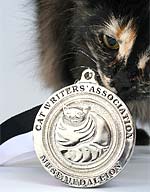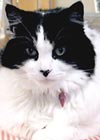 |
|||||||||||||||||||
|
|

We are the proud winners of the 2006 - 2009 winner of the Muse Medallion for Online Magazine by The Cat Writers? Association in their annual Communications Contest! (Photo courtesy of Weems Hutto).
On November 17, 2007 Felinexpress.com was honored to receive The President's Award by the Cat Writers' Association. We are very proud to have earned this distinction and will continue to provide quality information for all cat lovers.
Felinexpress.com Home > Senior Cats > Obesity in Senior Cats |
Obesity in Senior Cats
Obesity ranks as the number one health concern in the United States for both people and pets. Veterinarians nationwide agree, the majority of their obese patients are senior cats. “It’s a shame really,” Dr. Marla McGeorge DVM states.“Obesity is preventable!”
In her clinic, The Cat Doctor Clinic in Portland, Oregon, Dr. McGeorge works closely with her clients. Every initial exam includes cats being weighed and measured. Dr McGeorge pays special attention in developing individual nutritional programs in the hopes of fending off certain illnesses and diseases that often occur once the cat reaches the age of seven.
This age, according to Dr. Victoria J. Murdoch DVM of The Animal Clinic in Lebanon, Oregon is when cat owners need to schedule a Senior Panel (blood work). “When your cat reaches this age, you should have a baseline to work with. As cats become older and less active, their organs start to breakdown. You can catch problems before they start if your vet is monitoring blood levels.”
Engage your cat in play daily:
“The advantages of exercising the senior cat are similar to the advantages of exercise for humans who are seniors; weight control, good for joint and muscle health. Cats won’t become bored because you are mentally stimulating them. Pulling something along the ground or dangling an object in the air will peak a cat’s interest. Just be sure that this is supervised play only, and the object used is not small enough for the cat to swallow that might become a choking hazard,” advises Dr. McGeorge.
Use food wisely:
Feed several small meals a day versus free feeding. Don’t place your cat on a “crash diet.” Fat cats that are placed on these type of diets often end up fighting worse problems than obesity.
Place your cat’s food dish on the top level of a tall cat condo. She will have to climb up to eat. Unless she has an obvious disability or arthritis, she should welcome the activity. If the cat lies down refusing to climb, resort to other tricks to encourage movement.
Dr. Alice Moon-Fanelli, PhD, an Assistant Professor and certified-applied animal behaviorist at Cummings School of Veterinary Medicine at Tufts University offers her thoughts on seniors:
“Senior cats gain both physical and emotional benefits from interactive play time. Interactive play strengthens the emotional bond between cat and owner that promotes mental well being, keeping the mind limber. Just like people, cats have to ‘use it or lose it. You can make their food interactive as well.”
Food puzzles are great tools according to Dr. Moon-Fanelli. If you can’t find one readily available, you can make one easily at home.
“Take an empty toilet paper roll and punch a number of holes in the tube. These holes must be large enough for the dry kibble to pass through but not spill through. Fill the tube with dry kibble, seal off the ends with tape to contain the food.” The cat will bat the toy around and be rewarded with a tasty small meal she had to work for.”
Dr. Moon-Fanelli also suggests to use a sturdy cardboard box with holes cut in it: “Circular holes, three rows on top and one row along all four sides. The box can then be filled with a variety to toys that the cat has to reach for by fishing for them through the holes. You can also add cat treats to the mix, to make Fluffy work even harder to procure her meals.”
If you are worried you will wear out Fluffy with these games, you shouldn’t be to concerned. Dr. McGeorge states that it is “almost impossible to exercise a senior cat too much. The cat will simply stop when she has had enough.”
If you notice your cat has a continually dirty rear-end, her inability to groom herself may lie in the fact that she is just to fat to reach her rear-end. If she spends a great deal of time lying in the sun, unwilling to move much, spur her into action by appealing to her prey instinct.
Feeding birds outside a window where the cat can view the activity, installing a fish tank in the home, or getting your child that hamster he always wanted will stimulate her natural prey responses. Harness training is another consideration to help a fat cat become healthy and active again.
In her book Complete Care for Your Aging Cat, award-winning author Amy Shojai suggests you take a favorite toy or treat and hide it in places where the cat needs to stretch, bend, or “naturally practice feline yoga.”
Obesity in cats can lead to serious health risks. Older, obese cats fight: diabetes, constipation, hyperthyroidism, heart disease, arthritis joint disease, renal insufficiency (CRF).
Your first attack against obesity should begin the minute a new cat or kitten comes into your home. Implementing a good nutrition and exercise program with your vet becomes your best preventative measure against your cat becoming fat. Being aware of how much to feed, how many times to feed, the pros-and-cons of free feeding, quality food versus cheap generic food, the kitten or young adult cat under your care will thrive. Add to a good food program, responsible vet care and daily interactive play you now have all the tools necessary to wage war against your cat’s battle of the bulge.
More cat breeds |
|
? Copyright 2006-2010 Felinexpress.com, All Rights Reserved
Privacy Statement - Disclaimer - About Me


